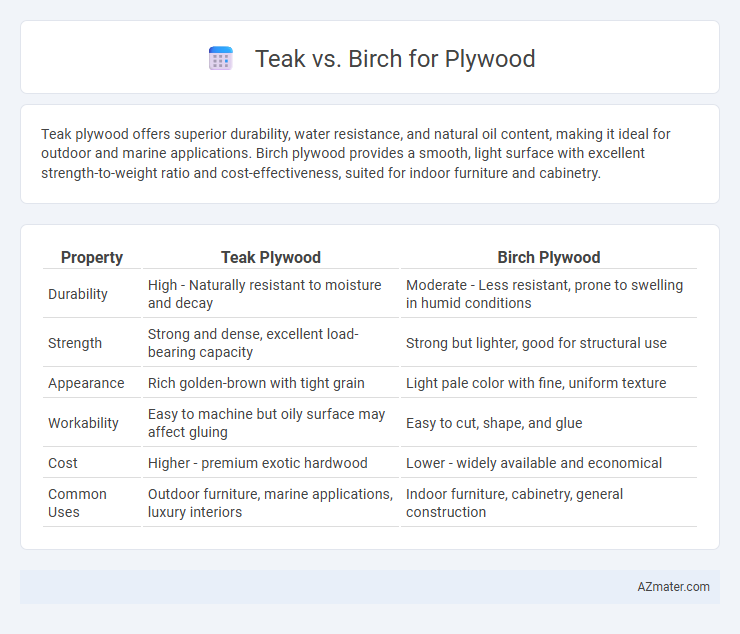Teak plywood offers superior durability, water resistance, and natural oil content, making it ideal for outdoor and marine applications. Birch plywood provides a smooth, light surface with excellent strength-to-weight ratio and cost-effectiveness, suited for indoor furniture and cabinetry.
Table of Comparison
| Property | Teak Plywood | Birch Plywood |
|---|---|---|
| Durability | High - Naturally resistant to moisture and decay | Moderate - Less resistant, prone to swelling in humid conditions |
| Strength | Strong and dense, excellent load-bearing capacity | Strong but lighter, good for structural use |
| Appearance | Rich golden-brown with tight grain | Light pale color with fine, uniform texture |
| Workability | Easy to machine but oily surface may affect gluing | Easy to cut, shape, and glue |
| Cost | Higher - premium exotic hardwood | Lower - widely available and economical |
| Common Uses | Outdoor furniture, marine applications, luxury interiors | Indoor furniture, cabinetry, general construction |
Introduction to Teak and Birch Plywood
Teak plywood is renowned for its exceptional durability, resistance to moisture, and natural oils that protect against pests and decay, making it ideal for outdoor and marine applications. Birch plywood offers a smooth surface, high strength-to-weight ratio, and consistent grain pattern, favored for furniture making and interior design due to its excellent machinability and finish quality. Both types provide versatile solutions with teak emphasizing weather resistance and birch excelling in structural integrity and aesthetic appeal.
Origins and Botanical Differences
Teak plywood originates from the Tectona grandis tree native to Southeast Asia, known for its dense, oily hardwood with natural resistance to moisture and pests. Birch plywood comes from Betula species primarily found in northern Europe, Russia, and North America, characterized by its fine grain and lighter, less oily wood. The botanical distinction lies in teak being a hardwood with natural oils contributing to durability, while birch is a temperate hardwood valued for its smooth texture and strength in plywood applications.
Appearance and Grain Characteristics
Teak plywood features a rich golden-brown hue with a tight, straight grain that offers a smooth and luxurious finish, making it ideal for high-end furniture and decorative applications. Birch plywood displays a pale cream color with a fine, even grain pattern that provides a uniform and clean appearance, perfect for contemporary designs and painted surfaces. The natural oils in teak enhance its durability and sheen, while birch's consistent grain ensures excellent strength and workability.
Strength and Durability Comparison
Teak plywood offers superior strength and exceptional durability due to its natural oils that resist moisture, pests, and decay, making it ideal for outdoor and heavy-use applications. Birch plywood, while strong and stable with a fine grain, is less resistant to moisture and wear, requiring proper sealing for long-term durability. In comparison, teak plywood outperforms birch in longevity and robustness, especially in challenging environmental conditions.
Moisture Resistance and Stability
Teak plywood offers superior moisture resistance due to its natural oils and dense grain, making it highly durable in humid or wet environments. Birch plywood provides excellent dimensional stability but is less moisture resistant compared to teak, often requiring additional sealing for water-prone applications. The choice between teak and birch plywood depends on the balance needed between moisture resistance and structural stability in specific projects.
Workability and Machining Properties
Teak plywood exhibits excellent workability with its natural oils aiding in smooth cutting and shaping, while birch plywood is highly favored for its fine grain and uniform texture that enhance precision machining. Birch plywood offers superior machining properties, including easier sanding and finishing, due to its consistent density and minimal resin content. Both materials perform well under common woodworking tools, but birch plywood is generally preferred for detailed joinery and intricate designs.
Cost and Availability in the Market
Teak plywood is generally more expensive than birch due to its high durability, natural resistance to moisture, and limited availability, making it a premium choice in the market. Birch plywood offers a cost-effective alternative with wide availability, favored for its consistent grain and strength suitable for interior applications. Market trends reveal that birch plywood is readily accessible in bulk, while teak plywood is more niche and often sourced from specialized suppliers, influencing overall project budgets.
Environmental Impact and Sustainability
Teak plywood offers exceptional durability and resistance to decay, sourced from slow-growing trees often managed in sustainably certified plantations, which helps mitigate deforestation concerns. Birch plywood, primarily harvested from fast-growing, renewable forests with higher replanting rates, generally has a lower carbon footprint and supports sustainable forest management practices. Choosing birch plywood typically results in a more eco-friendly option due to its rapid renewability and less intensive environmental impact compared to teak.
Best Use Cases for Teak vs Birch Plywood
Teak plywood excels in outdoor applications and marine environments due to its natural water resistance, durability, and resistance to pests, making it ideal for boat building, outdoor furniture, and high-end cabinetry. Birch plywood is best suited for indoor use where smooth finishes and aesthetic appeal are essential, such as in interior furniture, cabinetry, and decorative paneling, due to its fine grain and strength. Choosing teak plywood ensures longevity in harsh conditions, while birch plywood offers cost-effective versatility and ease of finishing for interior projects.
Conclusion: Choosing the Right Plywood for Your Project
Teak plywood offers exceptional durability and natural resistance to moisture and insects, making it ideal for outdoor and high-humidity environments. Birch plywood provides a smooth, consistent grain and superior strength, perfect for indoor furniture and cabinetry where aesthetics and structural integrity are key. Selecting the right plywood depends on balancing environmental exposure with desired appearance and budget, with teak excelling in longevity and birch favoring cost-effectiveness and versatility.

Infographic: Teak vs Birch for Plywood
 azmater.com
azmater.com